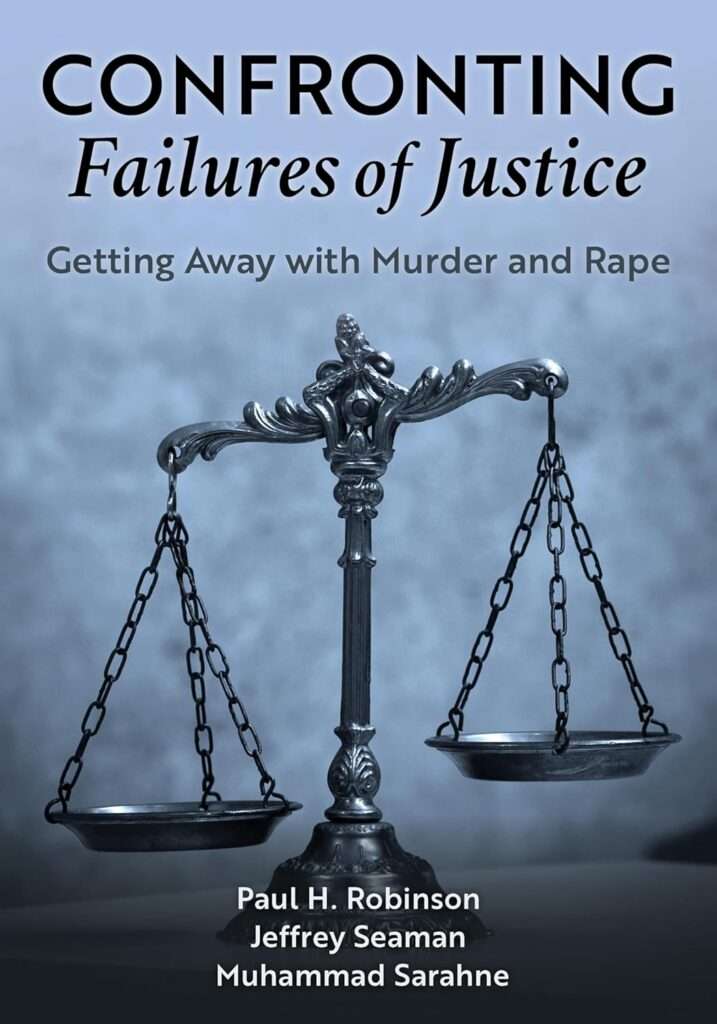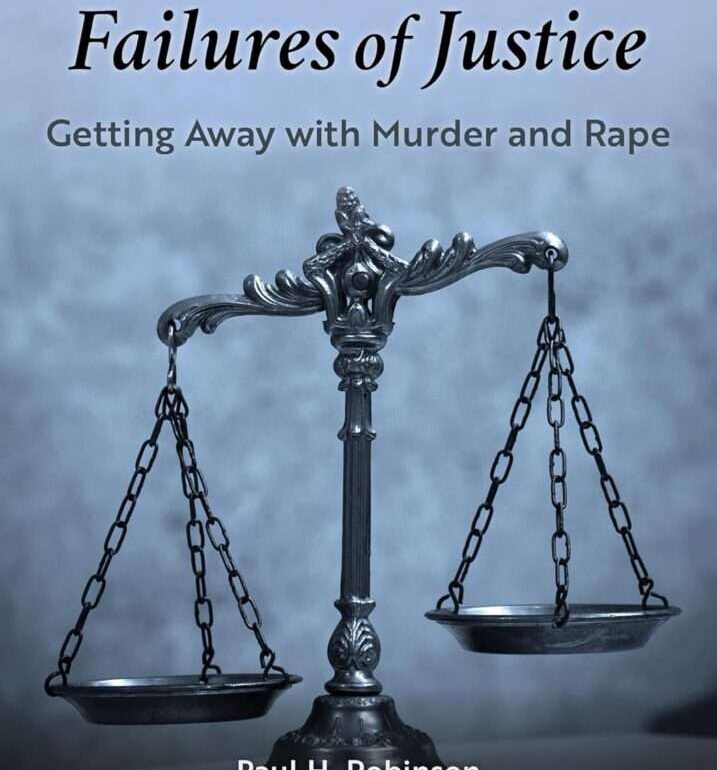
This is the third in a five-part series where we’re guest blogging about our new book Confronting Failures of Justice: Getting Away With Murder and Rape, available here. The last two posts introduced the problem of failures of justice (instances of unpunished or inadequately punished crime) and discussed how the problem is not solving itself. Now it’s time to talk about costs. Why should we care about failures of justice? One cost is moral—we, along with most people, believe that there is a moral obligation to punish serious crime. This argument could also be made in social contract terms—the government has a duty to its people to punish those who victimize them.
But in addition to these moral costs, failing to punish serious crime produces enormous real-world harms. These include trauma to victims and co-victims, as well as increased crime through loss of incapacitation, reductions in deterrence, and, perhaps most importantly, the consequences of a decline in the law’s moral credibility with the community. Consider an excerpt from our book discussing the harms caused to victims and their families.
Many serious, violent crimes leave victims alive but scar them with emotional trauma, especially when justice is not served. Surviving a rape or attempted murder is merely the beginning of suffering for most victims. A victim may well find some measure of solace and healing in the thought that their attacker has been caught and punished, but most victims of serious crime never experience that comfort…. It is impossible to quantify the suffering victims experience when their victimizers escape justice, but the cost is real and significant.… Studies have found that rape victims are more likely to experience post-traumatic stress disorder if they have “negative experiences with the criminal justice system” compared with those who have positive experiences with the system or even those who had no interaction with the system. The knowledge that one’s attacker still walks free can be infuriating and crippling to many victims.…
Rape is not the only crime with enormous personal costs. When a murderer or other serious violent offender gets away without deserved punishment, the victims’ families and friends are emotionally scarred. The relatives and friends of someone lost to homicide are often referred to as “co-victims,” a term that acknowledges that victimization extends far beyond the person killed. Anyone who has had a friend or a family member murdered will have to deal with lifelong grief, but a failure of justice adds anger, upset, and fear to that pain through the constant knowledge that the killer is free.
In the United States, it is estimated that roughly 9% to 15% of adults are co-victims of homicide and that roughly 8% to 18% of youths are co-victims of homicide. Since justice fails in more than half of such cases, around 5% or more of the population suffer from the knowledge that the killer of their loved one got away with murder. Worse, the co-victimization rates are staggeringly higher for other crimes, such as rape or aggravated assault, where the punishment rates are extremely low, even trivial.
But failing to punish serious crime does more than traumatize victims and their families. It also breeds more crime through several mechanisms.
First, low punishment rates decrease deterrence as criminals or would-be perpetrators correctly believe they are unlikely to be punished for any given crime. Another cost is failing to stop repeat offenders, since much, if not most, serious crime is committed by repeat offenders.
Failures of justice commonly leave the uncaught criminal free to reoffend, thus adding to the cost of crime which is estimated at a staggering 2.6 trillion dollars each year in America. Criminals rarely escalate from nothing to murder, and most serious crimes are committed by repeat offenders who have escaped justice repeatedly in the past. If the justice system was more effective in solving and punishing crime, repeat offenders would often have their careers ended earlier, avoiding a string of later crimes. Given the enormous costs of repeat criminals to society (even excluding the costs to victims and co-victims of letting offenders go free), allowing criminals to escape justice is unlikely to save societal resources on net. Doing justice ultimately more than pays for itself in the long run.
In addition to reducing deterrence and incapacitation, failing to justly punish crime carries another criminogenic cost through eroding the law’s moral credibility with the community.
Communities that witness repeated failures of justice commonly lose faith in the criminal justice system, which undermines the criminal law’s ability to gain compliance, deference, and assistance and, perhaps most importantly, to get people to internalize its norms. Instead of inspiring cooperation, a criminal justice system with reduced credibility provokes resistance, subversion, and rejection. This leads to increased lawbreaking and can provoke a justice-seeking backlash in the form of vigilantism … where members of the community take the law into their own hands and undertake to do justice where the system seems unwilling or unable to do it. Of all the pernicious effects of failures of justice, the criminal justice system’s loss of moral credibility with the community may be the most damaging because it creates a vicious cycle in which lost credibility produces more crime and less justice, which in turn reduces the system’s credibility further.
It should be common sense that when the justice system fails to do justice in most cases of serious crime, people notice and lose faith in that system. This dynamic is particularly noticeable in many of America’s urban neighborhoods where high rates of crime go together with high rates of crime non-reporting, witness non-cooperation, vigilante killings, and distrust in official justice system processes.
It is important to note that all the above costs apply regardless of whether a criminal completely escapes punishment or whether they are convicted and punished in a way the community sees as insufficient. Sometimes delivering a flagrantly inadequate punishment may be worse than delivering no punishment at all. For example, if an individual rapist escapes justice, it is unlikely to attract public attention. By contrast, the case of a rapist who is convicted but receives a slap on the wrist sentence (e.g., community service) is likely to spark far greater public outrage and cynicism because it showcases that the system is unable or unwilling to do justice even when a perpetrator is caught.
Yet another cost of failures of justice, and one that should be especially compelling to liberals and progressives, is the disparate impact unpunished crime has on poor and minority communities.
One final factor that makes the societal cost of justice failures all the more tragic and unjust is its disparately large impact on racial minorities and the economically disadvantaged.… Crime clearance rates are significantly lower in poorer areas with high racial minority populations than they are in White middle-income and high-income areas.… One analysis of 52 of the US’s largest cities found that police arrested someone in 63% of homicides that killed White victims, compared with just 47% of homicides of Black victims, a 16-percentage-point difference in clearance rates. Data from Chicago indicates that homicide cases involving a White victim are solved 47% of the time, cases involving a Hispanic victim are solved 33% of the time, and cases involving a Black victim have a clearance rate of a mere 22%.
There are several factors that likely contribute to these disparities (such as the type of killing, with street shootings being especially hard to solve), but regardless of the causes, the effect is clear: poor neighborhoods and minority communities suffer failures of justice at highly disproportionate rates to their share of the population.… Too often the same advocates who protest against police violence and decry the injustices caused by systemic racism in the legal system are nowhere to be found on the issue of solving and punishing crime.
No society should ignore the costs of failures of justice, particularly a modern liberal society that seeks to value and promote the rights and wellbeing of all its citizens. Unfortunately, justice failures may not receive the attention they deserve because academics, politicians, and society’s wealthy and powerful members are much less impacted by crime (and its subsequent lack of punishment) than are society’s worst-off members. The criminal justice system’s current policies and rules reflect a poor balance of societal interests that leaves most victims without justice and many communities locked in spirals of crime. The next post discusses the question of how to balance societal interests in criminal justice policy and who should do that balancing.
This post was originally published on this site be sure to check out more of their content.







